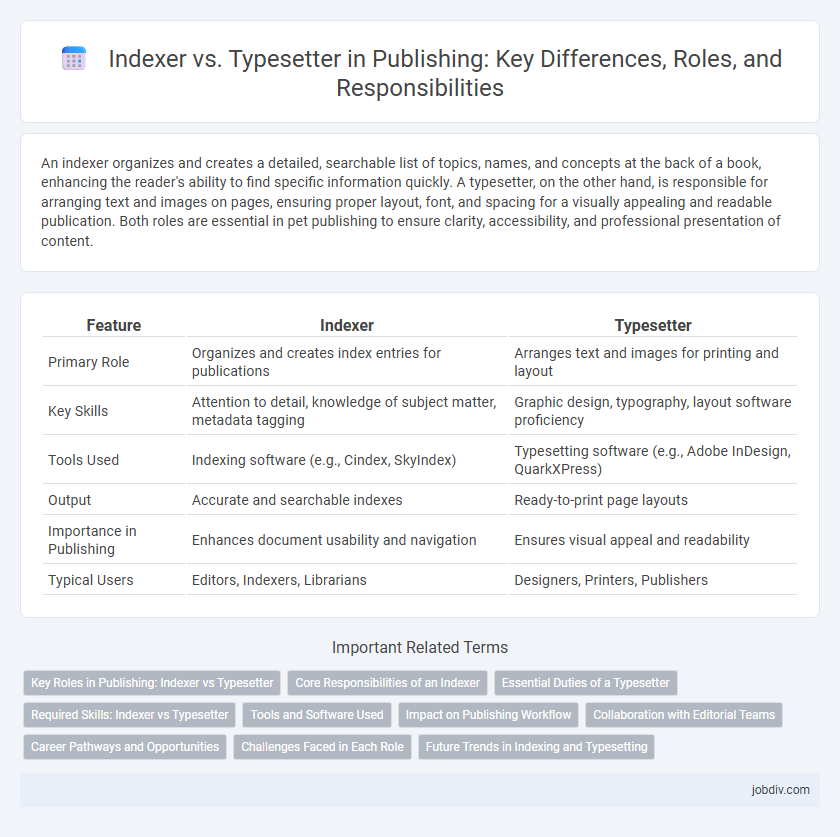An indexer organizes and creates a detailed, searchable list of topics, names, and concepts at the back of a book, enhancing the reader's ability to find specific information quickly. A typesetter, on the other hand, is responsible for arranging text and images on pages, ensuring proper layout, font, and spacing for a visually appealing and readable publication. Both roles are essential in pet publishing to ensure clarity, accessibility, and professional presentation of content.
Table of Comparison
| Feature | Indexer | Typesetter |
|---|---|---|
| Primary Role | Organizes and creates index entries for publications | Arranges text and images for printing and layout |
| Key Skills | Attention to detail, knowledge of subject matter, metadata tagging | Graphic design, typography, layout software proficiency |
| Tools Used | Indexing software (e.g., Cindex, SkyIndex) | Typesetting software (e.g., Adobe InDesign, QuarkXPress) |
| Output | Accurate and searchable indexes | Ready-to-print page layouts |
| Importance in Publishing | Enhances document usability and navigation | Ensures visual appeal and readability |
| Typical Users | Editors, Indexers, Librarians | Designers, Printers, Publishers |
Key Roles in Publishing: Indexer vs Typesetter
Indexers enhance a publication's accessibility by creating organized, detailed indexes that guide readers to specific information efficiently. Typesetters focus on the visual presentation, arranging text and images to ensure clarity, readability, and aesthetic appeal in the final printed or digital product. Both roles are essential in publishing, with indexers optimizing content navigation and typesetters refining format and layout.
Core Responsibilities of an Indexer
An indexer's core responsibilities include analyzing content to identify key terms and concepts, creating a structured alphabetical or thematic index that enhances document navigation, and ensuring accuracy and consistency in cross-references. They collaborate with authors and editors to understand subject matter deeply, selecting entries that maximize retrievability for readers. Unlike typesetters who focus on formatting and layout, indexers prioritize semantic organization and accessibility of information within publications.
Essential Duties of a Typesetter
Typesetters are responsible for arranging text and images to create visually appealing, accurate page layouts for print or digital publication, ensuring readability and consistency. They precisely adjust font styles, sizes, line spacing, and alignment to enhance the overall design while adhering to style guides and formatting requirements. Their role demands attention to detail, proficiency with layout software like Adobe InDesign, and collaboration with editors and designers to finalize the publication's presentation.
Required Skills: Indexer vs Typesetter
Indexers require strong analytical skills, attention to detail, and the ability to understand and organize complex content logically to enhance information retrieval. Typesetters need proficiency in desktop publishing software, a keen eye for design, and knowledge of typography to ensure visually appealing and readable layouts. Both roles demand meticulous accuracy, but indexers focus on content structure while typesetters emphasize visual presentation.
Tools and Software Used
Indexers primarily use specialized software like Cindex, SKY Index, and Macrex to efficiently create detailed and searchable book indexes, emphasizing accuracy and consistency. Typesetters rely on advanced layout and design tools such as Adobe InDesign, QuarkXPress, and LaTeX to format text and images for print or digital publication, ensuring aesthetic alignment and readability. Both roles depend on industry-specific software but focus on distinct technical processes: indexing targets content organization, while typesetting addresses visual presentation.
Impact on Publishing Workflow
Indexers enhance publishing workflow efficiency by improving content discoverability and searchability through precise metadata tagging and organization. Typesetters focus on the visual layout, ensuring consistency and readability that directly affect print and digital presentation quality. The collaboration between indexers and typesetters streamlines production timelines, reduces errors, and elevates the overall user experience in published materials.
Collaboration with Editorial Teams
Indexers work closely with editorial teams to ensure accurate and comprehensive content organization, facilitating efficient retrieval and enhanced user experience. Typesetters collaborate with editors to maintain consistent formatting standards that align with the publication's style guide, ensuring visual clarity and professional presentation. Both roles require seamless communication to harmonize content accuracy with aesthetic design, improving overall publication quality.
Career Pathways and Opportunities
Indexer careers focus on organizing content for efficient retrieval, requiring strong attention to detail and expertise in metadata standards, often leading to roles in information management and digital libraries. Typesetting offers pathways in layout design and print production, demanding proficiency in typography and software like Adobe InDesign, with opportunities expanding into digital publishing and multimedia design. Both fields provide specialized skill sets that support diverse roles across traditional and evolving publishing industries.
Challenges Faced in Each Role
Indexers face challenges in accurately categorizing and cross-referencing vast amounts of information to ensure easy navigation and retrieval. Typesetters encounter difficulties in maintaining consistency and precision in formatting, especially when dealing with complex layouts and diverse font requirements. Both roles require meticulous attention to detail to uphold the quality and usability of published content.
Future Trends in Indexing and Typesetting
Advancements in AI-driven indexers are enabling more precise semantic tagging and faster retrieval of complex content, transforming traditional indexing workflows. Automated typesetting systems now leverage machine learning to enhance layout adaptability across diverse digital platforms, optimizing readability and user engagement. Integration of cloud-based collaborative tools streamlines version control and real-time updates, ensuring efficient publishing cycles and consistent output quality.
Indexer vs Typesetter Infographic

 jobdiv.com
jobdiv.com